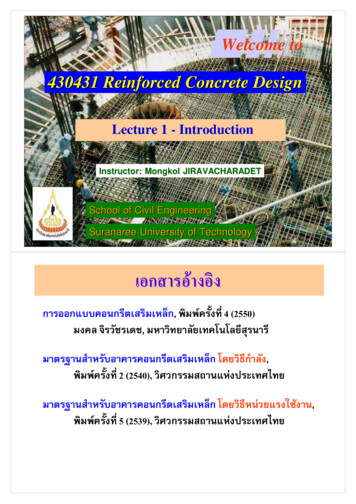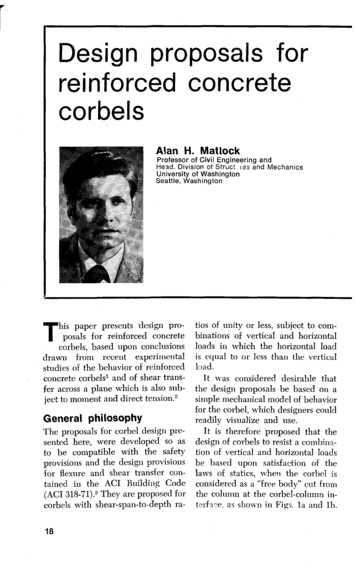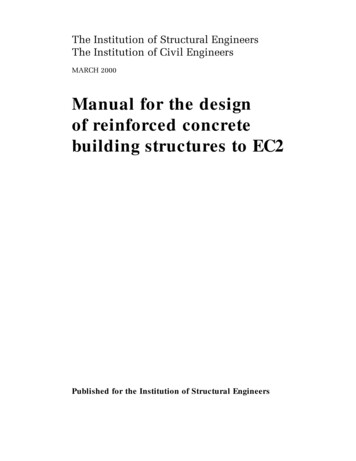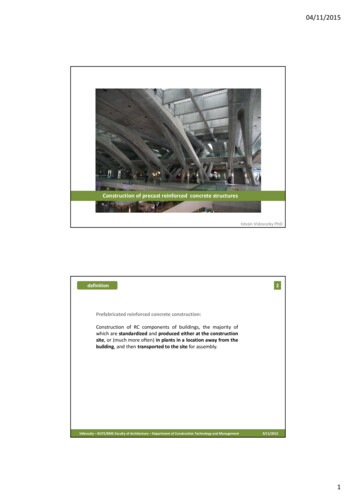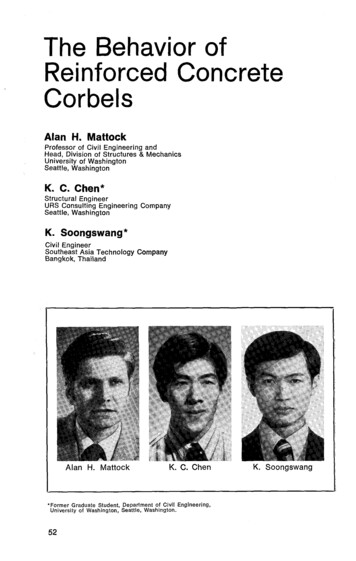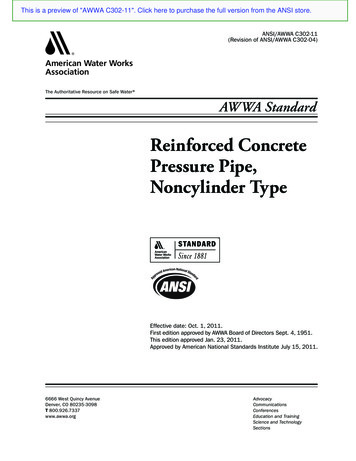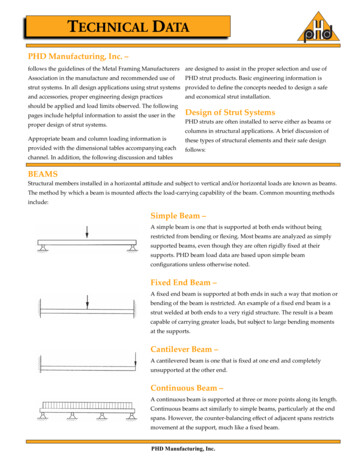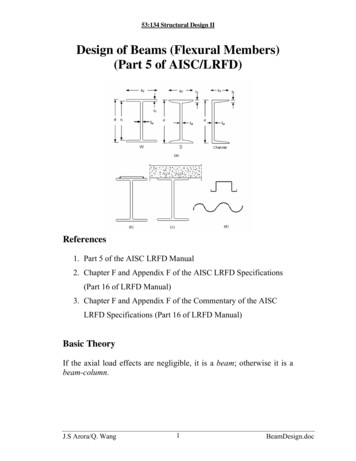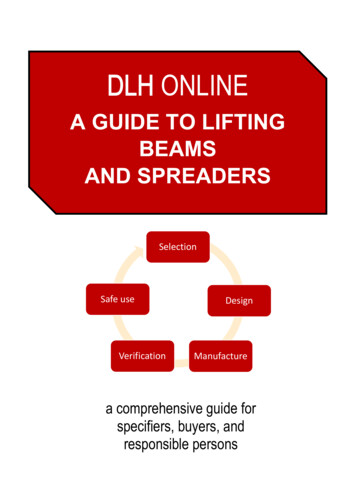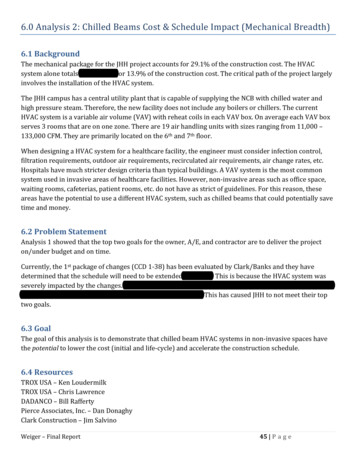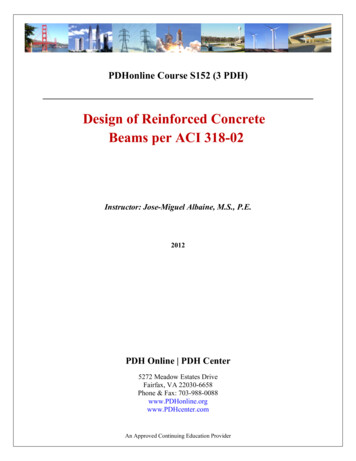
Transcription
PDHonline Course S152 (3 PDH)Design of Reinforced ConcreteBeams per ACI 318-02Instructor: Jose-Miguel Albaine, M.S., P.E.2012PDH Online PDH Center5272 Meadow Estates DriveFairfax, VA 22030-6658Phone & Fax: 703-988-0088www.PDHonline.orgwww.PDHcenter.comAn Approved Continuing Education Provider
www.PDHcenter.comPDH Course S152www.PDHonline.orgDesign of Reinforced Concrete Beams per ACI 318-02Course ContentA) Flexural Strength of Reinforced Concrete Beams and Slabs1. IntroductionThe design of reinforced concrete structural members may be done by twodifferent methods. One, called working stress design (WSD), is based on thestraight-line distribution of compressive stress in the concrete (Fig. 1),covered in Appendix B by ACI 318. This method was the prevalentmethodology up until the 1971 edition of the ACI code, and the evaluation isaccomplished using service loads.The other is known as the strength design method or ultimate strengthdesign (USD), and is the predominant design method used in the design ofreinforced concrete structures. This method will predict with satisfactoryaccuracy the maximum load that the structural member under considerationwill carry. The actual distribution of the compressive stress in a section hasthe form of a rising parabola (Fig. 2a), and an equivalent rectangular stressblock (Whitney block, Fig. 2b) can be used without loss of accuracy tocalculate the flexural moment strength of a section. This USD method willbe covered solely in this course.Other important stresses present in beams are shear stresses. These stressesare uniquely significant in concrete beams because when they combinedwith longitudinal stresses (due to flexure), they produce inclined stresses(diagonal tension) which in term induce diagonal cracks. The basicmechanism of these sloping cracks is the lack of tensile strength inherent inconcrete. For practical considerations the intensity of the vertical shear isdeemed to be a measured of the intensity of the diagonal tension. The ACIcode evaluates the shear strength of concrete section as being made up oftwo components: a) the shear strength of the uncracked concrete section, andb) the strength of the steel shear reinforcement. Shear is covered in ACIChapter 11.The following concrete structural elements are designed using the principlesaddressed in this course once the internal forces are determined: floor slabs,beams, girders, footings, and retaining walls.Page 1 of 21
www.PDHcenter.comPDH Course S152www.PDHonline.orgfcNeutralSurface1/3 kdc kdCenter of Compressionjd(1-k)dNeutral AxisddCenter of TensionbFigure 10.85f'c0.85f'cCcNeutralAxisca B1 ca/2C(d - a/2)dT As fsT As fsFigure 2aFigure 2b2. Design AssumptionsThe ACI code covers the design assumptions for flexural strength underChapter 10, section 10.2.Page 2 of 21
www.PDHcenter.comPDH Course S152www.PDHonline.orgTo compute the strength of a member using the strength design method ofthe ACI code requires that two basic conditions need be satisfied: (1) staticequilibrium, and (2) compatibility of strains.The following assumptions are made in defining the behavior of a beammember with span-to-depth (Ln/h) ratio greater than 4:1. Strain distribution is assumed to be linear. A cross section which wasplane before loading remains plane under load, (Fig. 3).2. Strain in the steel and the surrounding concrete is the same prior tocrushing of the concrete or yielding of the steel.3. Concrete in the tension zone of the section is neglected in the flexuralanalysis and design calculations, and the tension reinforcement isassumed to resist the total tensile force (Concrete tensile strength isapproximately 10% of its compressive strength).4. The maximum usable strain at extreme concrete fiber is assumedequal to 0.003.5. Stress in reinforcement below the specified yield strength, fy is takenas Es (modulus of elasticity of reinforcement) times steel strain εs. Forstrength greater than fy, the stress in the reinforcement is consideredindependent of strain and equal to fy.6. The relationship between the concrete compressive stress distributionand concrete strain is assumed to be rectangular, with concrete stressof 0.85f’c assumed uniformly distributed over an equivalentcompression zone (Fig. 2b).7. The distance c is measured from the fiber of maximum strain to theneutral axis in a direction perpendicular to that axis.8. The depth of the rectangular compressive block is taken as a β1cfrom the fiber of maximum compressive strain.9. Factor β1 is taken as 0.85 for concrete strengths f’c less and equal to4,000 psi. For strengths above 4,000 psi, β1 is reduced continuously ata rate of 0.05 for each 1000 psi of strength in excess of 4,000 psi, butβ1 shall not be taken less than 0.65 (Fig. 4).Page 3 of 21
www.PDHcenter.comPDH Course S152www.PDHonline.orgCompression side!ccNeutral AxisdhAs!sbTension sideFigure 3The value of the stress block depth factor β1:β1 0.85for 0 f’c 4000 psiβ1 0.85 – 0.05(f’c – 4000)/1000for 4000 psi f’c 8000 psiβ1 0.65for f’c 8000 psiFigure 4Using all the preceding assumptions, one can set the compression force Cequal to the steel tension force to satisfy the equation of equilibrium for theforces: See Fig. 2aC T (Equation 1)C can be written as 0.85f’cba, that is the volume of the compressive block ator near the ultimate when the tension steel has yielded, !s !yPage 4 of 21
www.PDHcenter.comPDH Course S152C 0.85f’cbawww.PDHonline.org(Equation 2)The tensile force T is then:T Asfy(Equation 3)Since C T0.85f’cba Asfy (Equation 4)the depth of the compression block is obtained from:a Asfy / 0.85f’cb (Equation 5)The moment of resistance of the section, the nominal strength Mn is:Mn (Asfy)jd or Mn (0.85f’cba)jd(Equation 6)Where jd is the lever arm, the distance between the compression and tensileforces of the internal resisting couple.Using the Whitney rectangular stress block shown from Fig. 2a, the leverarm,jd d – a/2(Equation 7)Then the nominal moment capacity becomes,Mn Asfy ( d – a/2)(Equation 8)Because C T, the moment can also be written as:Mn 0.85f’cba ( d – a/2)(Equation 9)3. General principles and requirementsThe ultimate moment at which a beam will fail needs to be calculated inorder to determine its ultimate strength. Two modes of failure are identified:(1) tension yielding of the steel, or (2) crushing of the concrete in the outercompression fiber. Depending on the type of failure, analysis of the strainstate in the tension reinforcement is the determinant factor in evaluating theductility of the reinforced section. The percentage of the tensionPage 5 of 21
www.PDHcenter.comPDH Course S152www.PDHonline.orgreinforcement will determine the magnitude of strain, and consequently thetype of failure (ductile or brittle).The ACI 318-02 addresses ductility in flexural members by stating theconcept of limiting tensile strain, while in previous code editions it wasimplicit in the maximum tension reinforcement ratio ρmax, that was given asa fraction of the balanced reinforcement ratio ρb.A balanced strain condition exists at a cross section when the maximumstrain at the extreme compression fiber reaches 0.003 simultaneously withthe yield strain εy fy /Es in the tension reinforcement. The new provisionsof the ACI code stated in sections 10.3.3, 10.3.4, and 10.3.5 defines thestrain limit for compression-controlled, tension-controlled, and transitionsections.Compression-controlled sections (ACI section 10.3.3) occur when the nettensile strain in the extreme tension steel is equal to or less than thecompression-controlled strain limit at the time the concrete in thecompression zone reaches the assumed strain limit of 0.003 (Fig. 5). Thecompression-controlled strain limit is the net tensile strain in thereinforcement at balanced condition. For Grade 60 steel, this limit is set at0.002.Sections are tension-controlled (ACI section 10.3.4) when the net tensilestrain in the tension steel reaches a value of 0.005 or more just as theconcrete in compression is equal to its strain limit of 0.003 (Fig. 6). In mostcases, the 0.005 limit will provide ductile behavior for acceptable designs.Sections with tensile strain in the extreme tension steel between thecompression-controlled strain limit and 0.005 are considered as part of thetransition strain limit zone (Fig. 7).Furthermore, for nonprestressed flexural members and nonprestressedmembers with axial load less than 0.10f’cAg, the net tensile strain εt islimited to 0.004 (section 10.3.5). This provision covers beams and slabswith small axial forces, and the minimum tensile strain allowed is 0.004.Note that prestressed members are exempted from this limitation.Page 6 of 21
www.PDHcenter.comPDH Course S152www.PDHonline.org!c 0.003 in/in!c 0.003 in/inc 0.375 dc 0.6 ddd! t 0.002 in/in! t 0.005 in/inCompression-Controlled Strain LimitTension-Controlled Strain LimitGrade 60 SteelFigure 5Figure 60.90!0.700.65SPIRALMin. for memberswith small axial forceSection 10.3.5OTHERTransitionCompressionControlled! t !yTensionControlled! t 0.004 ! t 0.005Strain Limit Zones and Variation of Strength Reduction Factor !with the Net Tensile Strain ! tFigure 7Page 7 of 21
www.PDHcenter.comPDH Course S152www.PDHonline.orgFrom the strain distribution of Fig. 3, the distance to the neutral axis isobtained by evaluating the similar triangles, thusc εc dt /(εs εc) 0.003d / (fs / Es 0.003)(Equation 10)Es Steel Modulus of Elasticity 29,000,000 psi (ACI section 8.5.2)If fs fy then the location of the neutral axis under balanced condition canbe computed as:cb 87,000 dt / (87,000 fy)(Equation 11)Similarly the strain in the steel reinforcement can be computed from thefollowing expression:εs 0.003(dt – c) / c(Equation 12)Note:ACI 318-02 introduced the term dt as the distance from extremecompression fiber to extreme tension steel. The effective depth, d is thedistance from extreme compression fiber to centroid of tensionreinforcement.Page 8 of 21
www.PDHcenter.comPDH Course S152www.PDHonline.org4. Minimum Reinforcement of Flexural MembersFlexural members requiring tensile reinforcement by analysis should beprovided with area of steel As not less than the followings per ACI section10.5:As,min 3f ' c bw d / fy but not less than 200bwd/fy (Equation 13)The above requirement is not required provided that the area of tensilereinforcement provided exceeds one-third that required by analysis;Asprovided (4/3) As req’d (Equation 14)For structural slabs and footings of uniform thickness the minimum area oftensile reinforcement in the direction of the span should be the same as thatrequired for shrinkage and temperature reinforcement (ACI section 10.5.3).Maximum spacing of this reinforcement must not exceed 18 inches, northree times the thickness of the section.Other provisions (section 10.5.2) are given for statically determinatemembers with a flange in tension, which is beyond the scope of this course.5. Distribution of Flexural Reinforcement in BeamsThe proper distribution of flexural reinforcement is required to controlflexural cracking in beams and slabs (ACI section 10.6). This sectionreplaces the z factor requirements of the 1995 and previous code editions.The spacing of the reinforcement closest to a surface must not be larger than:S 540/fs –2.5cc but less than 12(36/fs)(Equation 15)Where:fs calculated stress in reinforcement at service load in ksi. The stress canbe approximated as 60% of the specified yield strength, fycc clear cover from the nearest surface in tension to the surface of theflexural tension reinforcement, in.Page 9 of 21
www.PDHcenter.comPDH Course S152www.PDHonline.orgFor the usual case of beams with Grade 60 steel, and 2 in. clear cover to themain reinforcement, if fs is taken as 36 ksi, the maximum bar spacing is 10in.Structures subject to very aggressive exposure or designed to be watertight,will require special investigations and precautions.6. Lateral Supports for Flexural MembersThe spacing of lateral supports for a beam shall not exceed 50 times the leastwidth b compression flange or face (ACI section 10.4). Laterally unbracedreinforced concrete beams of reasonable dimensions, will not failprematurely by lateral buckling provided that they are not loaded with lateraleccentricity that induces torsion.7. New Load FactorsACI 318-02 has revised the load factor combinations and strength reductionfactors of the 1999 code. The old factors have been kept as an alternativeand are located in Appendix “C”.The 1999 combinations have been replaced with those of ASCE 7-98. Thebasic formulation for the USD method is stated as:Design Strength ! Required Strengthφ (Nominal Strength) ! UWhere:φ strength reduction factor (ACI section 9.3)U required strength to resist factored loads or related internal moments andforcesPage 10 of 21
www.PDHcenter.comPDH Course S152www.PDHonline.orgThe new φ factors are listed in section 9.3.2 and some are listed below:Tension-controlled sections . 0.90Compression-controlled sections(a) Members with spiral reinforcement 0.70(b) Other reinforced members . 0.65Transition members: See Fig. 7Shear and torsion 0.75Bearing on concrete 0.65The load factors were changed with the goal to unify the design professionon one set of load factors and combinations, facilitating the proportioning ofconcrete building structures that include members of materials other thanconcrete (i.e. steel).The required strength U is given as a set of load combinations in section 9.2,three of these commonly used combinations are listed below with the newload factors:U 1.2 D 1.6 L 0.5 (Lr S)U 1.2 D 1.6 (Lr or S) 1.0 LU 1.2 D 1.6 W 1.0 L 0.5 (Lr or S)Where:D dead loadsL live loadsLr roof live loadsS snow loadsW wind loadsNote the new load factors for dead loads (1.2 new, 1.4 old), and other cases(1.6 new, 1.7 old).Page 11 of 21
the ACI code requires that two basic conditions need be satisfied: (1) static equilibrium, and (2) compatibility of strains. The following assumptions are made in defining the behavior of a beam member with span-to-depth (Ln/h) ratio greater than 4: 1. Strain distribution is assumed to be linear. A cross section which was
